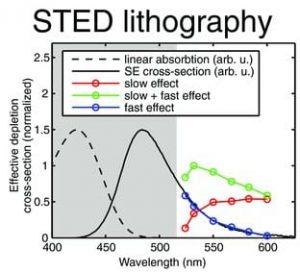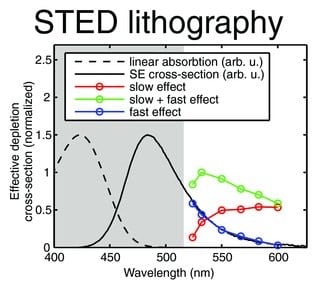Being able to produce arbitrarily complex 3D structures through a simple fabrication method is the ultimate goal in nanostructure pattering. Direct-laser-writing (DLW) optical lithography could be the method of choice. Typically, photoinitiator molecules in a photoresist are excited via two-photon absorption by a tightly focused laser beam, which initiate a polymerization reaction only within the light focus. The polymerized region is then the building block for more complex structures that are usually created by scanning either sample or focus. However, due to the wave nature of light the focal spot cannot be smaller than about 100 nm. Therefore DLW is not yet a true nano-technology.
In 2010 Joachim Fischer and Martin Wegener (Karlsruhe Institute of Technology) succeeded in the implementation of diffraction unlimited DLW optical lithography by using a second beam to fully reversibly inhibit the polymerization in a stimulated emission depletion (STED) inspired configuration (s ee figure). Being able to stop the radical formation, which initiate the polymerization, makes it possible to only allow polymerization in a much smaller region than the focal spot rendering real nano-patterning possible.
ee figure). Being able to stop the radical formation, which initiate the polymerization, makes it possible to only allow polymerization in a much smaller region than the focal spot rendering real nano-patterning possible.
Now the authors could undoubtful ly identify the underling process for polymerization inhibition in a novel photoresist containing a ketocoumarin photoinitiator. Lithography experiments with time-delayed laser pulses of variable wavelengths revealed a slow and a fast component with distinct spectral signatures. The fast component exhibits a time constant of about 1 ns and spectrally follows the anticipated gain spectrum. Thus it can be assigned to stimulated emission. This analysis lays the foundation for systematically optimizing the conditions in next-generation STED-DLW optical lithography.
ly identify the underling process for polymerization inhibition in a novel photoresist containing a ketocoumarin photoinitiator. Lithography experiments with time-delayed laser pulses of variable wavelengths revealed a slow and a fast component with distinct spectral signatures. The fast component exhibits a time constant of about 1 ns and spectrally follows the anticipated gain spectrum. Thus it can be assigned to stimulated emission. This analysis lays the foundation for systematically optimizing the conditions in next-generation STED-DLW optical lithography.
The research is reported in the first issue of Advanced Optical Materials, the new section in Advanced Materials (2010 IF: 10.880) dedicated to exploring light-matter interactions. The paper, “Ultrafast Polymerization Inhibition by Stimulated Emission Depletion for Three-dimensional Nanolithography“, is available for free for Wiley Online Library now.

















